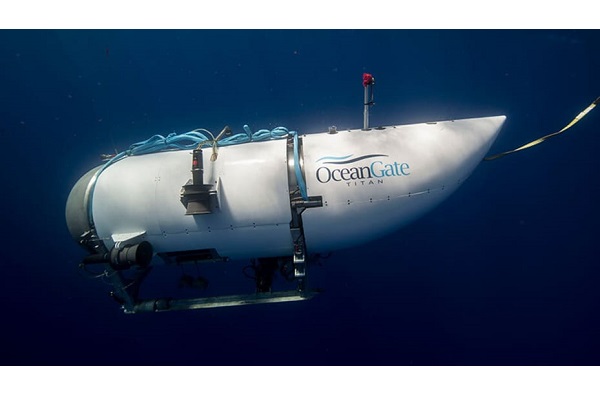PESHAWAR: The Supreme Court on Monday suspended the Peshawar High Court’s (PHC) verdict denying the Sunni Ittehad Council (SIC)
NORTH ATLANTIC: Rescuers searching for a missing tourist submersible near the wreck of the Titanic have detected “underwater noises” in the search area, the US Coast Guard said on Wednesday, with oxygen for the five on board rapidly running out more than two days after they lost contact.
All communication was lost with the 21-foot craft during its descent Sunday to see the remains of the British passenger liner, which sits more than two miles (nearly four kilometers) below the surface of the North Atlantic.
The Titan, operated by US-based OceanGate Expeditions, was built to stay underwater for 96 hours, according to its specifications — giving the five people aboard until Thursday morning before air runs out.
Engro Corp Vice Chairman Shahzada Dawood, his 19-year-old son Suleman, British billionaire Hamish Harding, French explorer Paul-Henri Nargeolet, OceanGate CEO Stockton Rush were on board the craft that went missing near the wreck of the Titanic.
US and Canadian coast guard ships and planes are scouring 7,600 square miles of ocean (around 20,000 square kilometers) — larger than the US state of Connecticut — for the vessel, which was attempting to dive about 400 miles off the coast of Newfoundland, Canada.
“Canadian P-3 aircraft detected underwater noises in the search area. As a result, ROV (remotely operated vehicle) operations were relocated in an attempt to explore the origin of the noises,” the US Coast Guard’s First District said on its official Twitter page.
The ROV searches “have yielded negative results but continue,” the maritime military branch added.
The Coast Guard did not detail the nature or extent of the sounds that were detected, or how they were picked up.
But CNN and Rolling Stone magazine, citing internal US government communications, independently reported late on Tuesday that banging sounds were detected by Canadian aircraft at 30-minute intervals in the search area.
Rolling Stone, the first to report the news, said the sounds were detected by sonar buoys deployed in the area “close to the distress position” and that additional sonar picked up more banging four hours later.
CNN cited a US government memo also as saying that additional sounds were heard about four hours after initial banging were detected, although the news channel said the second occurrence of noise was not described as banging.
“Additional acoustic feedback was heard and will assist in vectoring surface assets and also indicating continued hope of survivors,” CNN quoted the updated government memo as saying.
It was not immediately clear if the news reports were based on the same source.
Rescue aid has been pouring in from around the world, with a specialised winch system for lifting heavy objects from extreme depths, other equipment and personnel due to join the rescue effort on Tuesday night, according to the US Navy.
The Pentagon said it was deploying a third C-130 aircraft and three C-17s, while France’s oceanographic institute announced a deep-sea underwater robot and its experts would arrive in the area on Wednesday.
Search for missing sub like ‘going into space’
Rescuers trying to find the orca-sized submersible are facing a gargantuan task that will test the limits of technical know-how, experts say.
“It’s pitch black down there. It’s freezing cold. The seabed is mud, and it’s undulating. You can’t see your hand in front of your face,” Titanic expert Tim Maltin told NBC News Now.
“It’s really a bit like being an astronaut going into space.”
US Coast Guard Captain Jamie Frederick told reporters on Tuesday that his organisation was co-ordinating the search.
But, he said, it was incredibly difficult, and far beyond what the coast guard would normally tackle.
“While the US Coast Guard has assumed the role of search and rescue mission coordinator, we do not have all of the necessary expertise and equipment required in a search of this nature,” he said.
“This is a complex search effort, which requires multiple agencies with subject matter expertise and specialized equipment.”
Frederick explained that rescuers were using multiple methods as they comb the vast area for the Titan, which lost contact with its mothership just two hours into its dive near the Titanic’s watery grave.
“The search efforts have focused on both surface with C-130 aircraft searching by sight and with radar, and subsurface with P3 aircraft, we’re able to drop and monitor sonar buoys.”
The effort was being augmented on Tuesday by a huge pipe-laying vessel, which has a remotely operated vehicle expected to be deployed at the Titan’s last known position.
Jules Jaffe, who was part of the team that developed the optical imaging system used to find the Titanic in 1985, said rescuers would have to look in three separate places.
“It’s either sitting on the seafloor, somewhere in the water column, or sitting on the surface,” he told ABC10 in San Diego.
“It could be in the water column. I think that’s probably the most likely place it is.”
Jamie Pringle, a professor of forensic geosciences at Keele University in Britain, said if the mini-sub had settled on the ocean floor, it could be very difficult to spot.
“The bottom of the ocean is not flat; there are lots of hills and canyons,” Pringle said, according to NBC.
Adding to the challenge: the enormous pressure four kilometers under water, around 400 times what it is on the surface.
You May Also Like
GAZA: Palestinian militant group Hamas on Monday agreed to a Gaza ceasefire proposal from mediators, but Israel said the terms did not meet
WASHINGTON: A former high-profile agent of the US Federal Bureau of Investigation (FBI), Kamran Faridi has been released from a Florida






